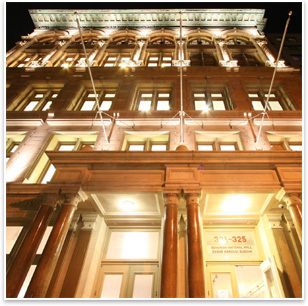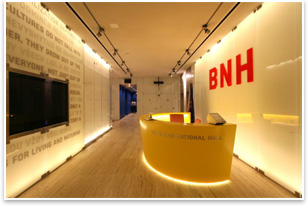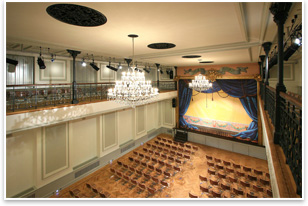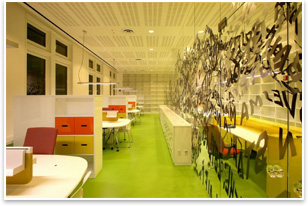
| Bohemian National Hall Flourishes Anew Place for Czech culture restored to former glory on NYC’s East Side
Summary: The Bohemian National Hall aims to market itself as a distinctive, recognizable, elegant gathering spot in New York City and establish itself as a brand associated with a specific segment of the city’s cultural life. It is a place with character and with the specific angle of bringing and presenting Czech culture, in its diversity, to a city of diversity, not simply an ordinary open space to be rented, says a marketing representative for the century-old building. The Bohemian National Hall, once a place where Czech culture thrived, but a long-since forlorn building, reopened in October in its Upper East Side neighborhood after being out of service for 40 years. A $45 million renovation revived the building's Classical 19th-century exterior and updated the interior to modern standards. The renovation rekindles important cultural and ethnic traditions once celebrated by Czech immigrants.
The newly renovated five-story building, which initially was called Narodni Budova (National Building), contains a multipurpose ballroom that can hold 300 people and includes more than 32,000 square feet of new space. The ballroom is suitable for dancing, weddings, corporate events, conferences, movie productions, and photo shoots. The Bohemian National Hall also houses the offices of the Czech Consulate General and the Czech Center, as well as the Bohemian Benevolent and Literary Association (BBLA). Other features include a 70-seat, state-of-the-art theater and a library collection focusing on history, art, and literature (in Czech, Slovak, and English). Additionally, an upscale, restaurant/lounge featuring Czech cuisine is in the works. “The premise behind this multi-purpose facility was to create a platform for showcasing the Czech culture as well as being able to promote Czech business,” says Pavel Semerák, the owner’s representative for the Czech Foreign Ministry. “The place will further cooperation and relationship between the people of the Czech Republic and their fellow Americans.”
The complete renovation took five years because it was staged over separate phases, Semerák explains. First was the core and shell, the second phase was the entire floor renovation for the BBLA, and, third, the interior work and all special technologies, including audio-visual, theatrical, special lighting, and others for the rest of the building.
The most “intricate element must have been the new spiral staircase between the first and second floor,” Semerák says. ‘It was challenging architecturally, and its structural stability was also tricky. The decision to put it there came quite late into the last phase.” He notes that dealing with the bureaucracy of the Czech government, the project sponsor, and New York City building code requirements “was probably the most exciting part.”
“An integral part of the deal of receiving the building from BBLA for a symbolic $1 was the obligation and willingness to restore the facility to its former glory and to preserve its cultural heritage. The Czech government understands the value of the building, both economical and historical. These were valid reasons for the use of the Czech taxpayer’s money,” Semerák says. |
||
Copyright 2008 The American Institute of Architects. All rights reserved. Home Page |
||
news headlines
practice
business
design
recent related
› Born in Brooklyn: the Ashland Center
Visit the Czech Center Web site.
To mark the start of the new journey, the Bohemian National Hall presents a groundbreaking exhibition entitled "Czech Places, Memory Traces. The Bohemian National Hall and Other Stories." The exhibition offers a compelling portrait of Czech immigrants and chronicles the rise and fall of Manhattan’s Bohemian neighborhoods by means of an impressive selection of archive photos.
The hall became a major center for Czech culture in New York City, with composer Antonin Dvorak taking part in fundraising efforts for the building. During these early years, the center notes, Dvorak’s music could often be heard throughout the building. More than 50 Czech organizations occupied the building, which also hosted thousands of galas, wedding receptions, and church ceremonies. The Manhattan Theatre Club, which rented space in the building in the 1970s, used the ornate theater to stage the debut of Liza Minelli.
See what the AIA’s Historic Resources Committee is up to.
The AIA’s resource knowledge base can connect you to practice, design, and leadership resources. See what a search of SOLOSO has to offer for your practice.
Photos
Photos taken by Pavel Semerák.

 How do you . . .
How do you . . .  “We’re very excited about the programs that will bring people to the hall,” says Marcel Sauer, director of the Czech Center of New York, which is housed in the renovated building. “We’ve put on a lot of programs that have generated a wide range of interests. We are very pleased to see people coming to the new building.”
“We’re very excited about the programs that will bring people to the hall,” says Marcel Sauer, director of the Czech Center of New York, which is housed in the renovated building. “We’ve put on a lot of programs that have generated a wide range of interests. We are very pleased to see people coming to the new building.” Many uses, hopefully more functions
Many uses, hopefully more functions He also notes that great care and effort marked the restoration of the ballroom. “The walls were rebuilt with masonry, all moldings and trim were done in real plaster. The woodwork from the Czech Republic is hand painted, the travertine and hardwood flooring was also brought from the homeland.”
He also notes that great care and effort marked the restoration of the ballroom. “The walls were rebuilt with masonry, all moldings and trim were done in real plaster. The woodwork from the Czech Republic is hand painted, the travertine and hardwood flooring was also brought from the homeland.” Historic ties
Historic ties